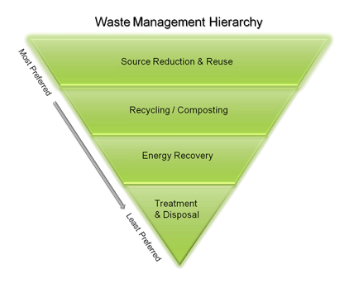It’s time to trash recycling

Recycling can still be a viable option, but it needs to work alongside reducing and reusing. Waste Management Hierarchy taken from EPA.
March 21, 2023
Americans have gone from producing 2.68 pounds of garbage per day in 1960 to 4.59 pounds per day in 2018. To deal with this influx of waste, the amount we recycle has increased significantly since 1960. Recycling is only one part of our waste management solution. Reducing and reusing are both viable solutions and are better than recycling.
The Environmental Protection Agency (EPA) states that reducing and reusing are better waste management methods than recycling as they ultimately produce less waste and less emissions. But according to EPA statistics, most of our trash ends up in a landfill or being recycled. Recycling has become common, but it has downsides that reducing and reusing don’t have.
Recycling is a great alternative when you cannot reduce or reuse, but it still comes with many issues that affect our economy and environment. The recycling process consumes heavy amounts of energy and emits VOC (volatile organic compounds) that hold chemicals such as trichloroethylene and vinyl chloride which are heavily toxic for humans and animals. This process also has its toll on the economy, as recycling increases upfront capital costs and processing costs.
Studies have shown that 30% of mixed recyclables are never recycled and are ultimately contaminated by non-recycle materials. And according to the Occupational Safety and Health Administration, certain recycled materials such as scrap metal, oil, and electronics hold deadly chemicals that can become hazardous for workers.
Reducing and reusing are better for the environment because they produce less trash; but still, the trash that people produce has increased 1.91 pounds per day since 1960 which shows just how little the first two Rs are being used. Though reduce, reuse, and recycle are preached, people continue to mainly recycle. If people know that reducing and reusing are better for the environment, why do only a small amount of people participate in it? The simple answer: recycling is easier. Recycling bins can be found everywhere, even in public places. Where there is a trashcan, there is almost always a recycling can.
The abundance of recycling bins is not the only thing that makes recycling easy, but also the fact that recycling does not require a change of consumption. The same new things can be bought but can then be recycled. With reducing and reusing, a change of consumption is required, but that doesn’t mean that it has to be hard.
The recent normalization of thrifting items such as clothing, décor and practically anything that can be donated has had an extremely beneficial effect on the environment as well as student’s wallets. The cycle of donating and thrifting keeps items out of landfills and gives the opportunity for cheap, unique and environmentally friendly clothing options. Thrifting is one of the most popular and trendy forms of reusing. According to the EPA, Americans generate 16 million tons of textile waste per year. Alexa Denglar (‘26) is very enthusiastic about reusing by the means of thrifting.
“I reuse the most because I thrift clothing very often at Goodwill, Savers and I also go to used bookstores a lot as well,” Denglar said.
Denglar, unlike the majority of students, is actively improving the health of the environment by choosing to reduce and reuse instead of recycling.






